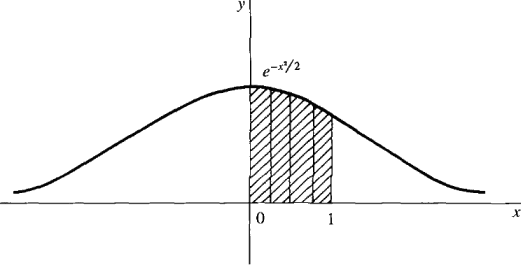| The ebook Elementary Calculus is based on material originally written by H.J. Keisler. For more information please read the copyright pages. |

|

Home  Integral Integral  Numerical Integration Numerical Integration  Examples Examples  Example 3: Simpsons Rule Applied Example 3: Simpsons Rule Applied |
|||||||||||||||||||






|
|||||||||||||||||||
Example 3: Simpsons Rule Applied
Use Simpson's Rule with Δx = 0.25 to approximate the integral
and find the error estimate. The curve is the normal (bell-shaped) curve used in statistics, shown in Figure 4.6.5. We are to divide the interval [0, 1] into four subintervals of equal length Δx = 0.25. The following table shows the values of x and y and the coefficient to be used in Simpson's approximation for each partition point.
Figure 4.6.5 Example 3
The sum used in the Simpson approximation is then [1.000000 + 4 · (0.969233) + 2 · (0.882496) + 4 · (0.754840) + 0.606531] = 10.267816 To get the Simpson approximation, we multiply this sum by Δx/3: S = (10.267816) · (0.25)/3 = 0.855651. To find the error estimate we need the fourth derivative of y = e-x²/2. The fourth derivative can be computed as usual and turns out to be y(4) = (x4 - 6x2 + 3)e-x²/2. On the interval [0, 1], y(4) is decreasing because both x4 - 6x2 + 3 and - x2/2 are decreasing, and therefore y(4) has its maximum value at x = 0 and its minimum value at x = 1, maximum: y(4)(0) = 3 minimum: y(4)(1) = -1.213061 The maximum value of the absolute value |y(4)| is thus M = 3. The error estimate in Simpson's Rule is then
This shows that the integral is within 0.000065 of the approximation; that is,
or using inequalities,
For comparison, a more accurate computation with a smaller Δx shows that the actual value to six places is
The Trapezoidal Rule for this integral and the same value of Δx = 0.25 give an approximate value of 0.85246 for the integral and an error estimate of 0.00521.
|
|||||||||||||||||||
Home  Integral Integral  Numerical Integration Numerical Integration  Examples Examples  Example 3: Simpsons Rule Applied Example 3: Simpsons Rule Applied |
|||||||||||||||||||
Last Update: 2010-11-26







